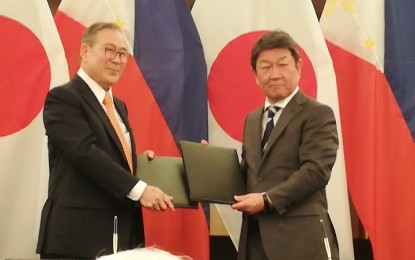
Japanese Foreign Minister Motegi Toshimitsu and Department of Foreign Affairs Secretary Teodoro Locsin, Jr. sign and exchange the diplomatic notes on the Metro Manila Priority Bridges Seismic Improvement Project (Phase II) in Makati on Thursday (Jan. 9, 2020). The project will improve the resilience of two major bridges in the metropolis, Lambingan Bridge and Guadalupe Bridge, through the incorporation of improved seismic bridge design specifications. (PNA photo)
Hoping for a better relationship between the Philippines and Japan, Japanese Foreign Minister Motegi Toshimitsu ended his first official visit to the Philippines promising support for the country’s infrastructure projects.
Toshimitsu signed diplomatic notes with his Philippine counterpart Teodoro Locsin, Jr providing for a Y4.4 billion or P2 billion supplemental funding for the Metro Manila priority bridges seismic improvement project.
The project, originally entered into in August 2015, is aimed to strengthen earthquake resilience of the Lambingan and Guadalupe bridges in Metro Manila.
The added funds are meant to finance the extension of the project until August 2023.
“Recently, several large-scale earthquakes struck various places in the Philippines such as Manila and Mindanao. I would like to express my heartfelt condolences to those who lost their lives, the victims and their family. Japan wishes to cooperate by leveraging on our knowledge in responding to natural disasters, which is a common challenge to both our countries,” Motegi said.
Beyond bridges, Locsin thanked Japan for its constant support for other infrastructure projects such as the first subway in the country and the north to south commuter railway which Motegi hoped will ease traffic in Metro Manila.
“The project will reinforce our bridges, bringing them to superior seismic design specifications and making them resilient to large-scale tremors,” Locsin Jr. said.
Finance Secretary Carlos Dominguez saw more opportunities for financing and technical support from Japan as it spends eight trillion pesos on “Build, Build, Build” projects.
One such opportunity, Japan international cooperation agency’s development of a masterplan to develop Subic Bay, a former U.S. naval base north of Manila, into an important node of knowledge-based industry in East Asia.
Meanwhile, Locsin acknowledged Japan’s assistance in the Philippines’ acquisition of new air and maritime assets and equipment as well as support for the Mindanao peace process.
“Japan is what we call a consistent “podium finisher”: it is the Philippines’ second largest trade partner, third largest investor, the top provider of ODA [official development assistance], and ranks a close fourth in terms of inbound tourism.”
In turn, Motegi expressed support for the disarmament process of Moro rebel groups and thanked the Philippines for lifting an import ban on Japanese food.
It was Locsin’s first bilateral meeting with Motegi who was only appointed September last year.
Aside from official development assistance and infrastructure, they also discussed issues on defense and maritime security, issues in the Middle East and other regional issues.
But it was not only Motegi who promised support.
Japan has also committed to donate eight million pesos to construct a two-storey dormitory housing for deaf children. (Jasper Camilo)